The ambitious undertaking in the traveling exhibition Black Refractions: Highlights from The Studio Museum in Harlem to summarize the prodigious achievements of artists of African descent over the last century astounds in its impressive displays.
There is the larger-than-life oil canvas portrait of Kevin the Kiteman, a 2016 work by Jordan Casteel, set against a rich, lushly textured representation of a Harlem street that evokes joyful contentment. Chakaia Booker’s 1995 sculpture of rubber tires and metal, Repugnant Rapunzel (Let Down Your Hair), challenges the viewer to contemplate the moral and ethical implications of an industry that historically has exploited the labor of young African people. Kerry James Marshall’s 1986 Silence is Golden, a work of acrylic on panel, riffs convincingly on the themes of Ralph Ellison’s 1952 novel Invisible Man. The stunning shimmering effect of Mickalene Thomas’ Panthera, a 2002 work of a panther rendered in rhinestones on acrylic and a birch panel, resonates as an expression of the strength and beauty of the Black woman. Black Righteous Space by Hank Willis Thomas is a 2012 video installation, which immerses the viewer in a visceral historical counterpoint incorporating elements ranging from the Confederate flag’s stars and bars to the Pan-African tricolor flag of black, red and green, along with the voices of black cultural leaders.

At the center of the installation is a microphone for exhibition visitors to answer the call and voice their own response. Kehinde Wiley, who was commissioned in 2018 to create the official portrait of former President Barack Obama, references an 18th-century French tapestry to create his own Jacquard tapestry with The Gypsy Fortune-Teller. Wiley, of course, is well known for depicting subjects in contemporary outfits and fashion, who historically have been excluded from representations in the elaborate, ornate backgrounds of classic art media and aesthetics.
The Utah Museum of Fine Arts is the fifth of six U.S. destinations to host the traveling exhibition, thanks to the efforts of the American Federation of Arts and the Studio Museum in Harlem. The exhibition will be at the UMFA through April 10. UMFA and the Smith College Museum of Art in Northampton, Massachusetts, are the only two college-affiliated institutions in the traveling tour. UMFA’s presentation of the exhibition also is supported by the university’s Black Cultural Center.
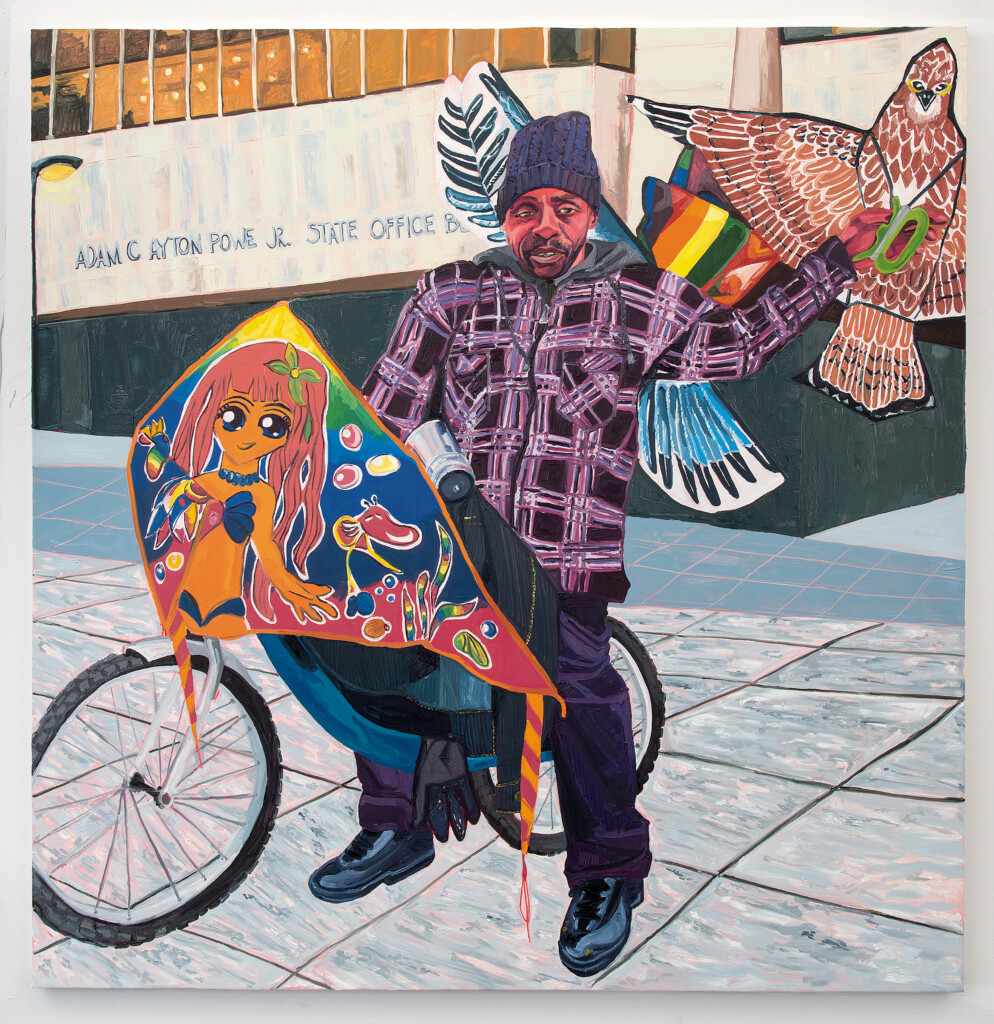
The Studio Museum is currently closed to the public as construction proceeds on its new home in Harlem. The museum’s previous homes have been in a second story loft and a 100-year-old building that housed variously a bank and a furniture store. Its new home will be the first facilities designed for the institution’s specific mission and needs, since it opened in 1968. The Studio Museum’s new home, designed by architect David Adjaye, will be located on Harlem’s most iconic thoroughfare: West 125th Street. Choi, in an interview with The Utah Review, says that as construction continues, “we’re deepening our roots and partnerships in the Harlem community as we think about how we will broaden our programming, education and engagement.”
With 100 works from nearly 80 artists dating to the 1920s, Black Refractions is a magnificent and generous sampling of the Studio Museum’s expansive collections representing not just acquisitions but also works of many artists who have developed their creative expression through artist residencies at the institution. The residencies have been instrumental to the museum’s development since its earliest days.

For pandemic-weary individuals who might be thirsting to travel to iconic institutions in the nation’s art landscape, Black Refractions truly brings the experience handily to the doorstep for UMFA patrons, students, artists, teachers and art enthusiasts. Take, for example, Glenn Ligon’s 2007 work of PVC and neon, which had graced the Studio Museum’s lobby up until its closing for construction of its new facilities. Give us a Poem (Palindrome #2) is an homage to Muhammad Ali’s famous response to a student’s request for a poem during a 1975 Harvard University appearance. That poem was “me, we,” now preserved in flashing neon lights as a wonderfully relevant signal to guide the viewer’s journey through the Black Refractions exhibition.
The traveling exhibition was curated by Connie Choi, the Studio Museum’s associate curator, who worked with UMFA’s Whitney Tassie, a senior curator and curator of the museum’s contemporary and modern art collections. Rather than organize the works in galleries by chronology or media, Choi wisely anchored the exhibition on multidimensional perspectives that command the viewer’s attention to consider the deeper implications and themes of artists of African descent as adding to and broadening the history of the American art experience. The narrative and aesthetic emphases on display dramatically pinpoint what it means in fulfilling the expectations and elucidating results of diversity and inclusion.
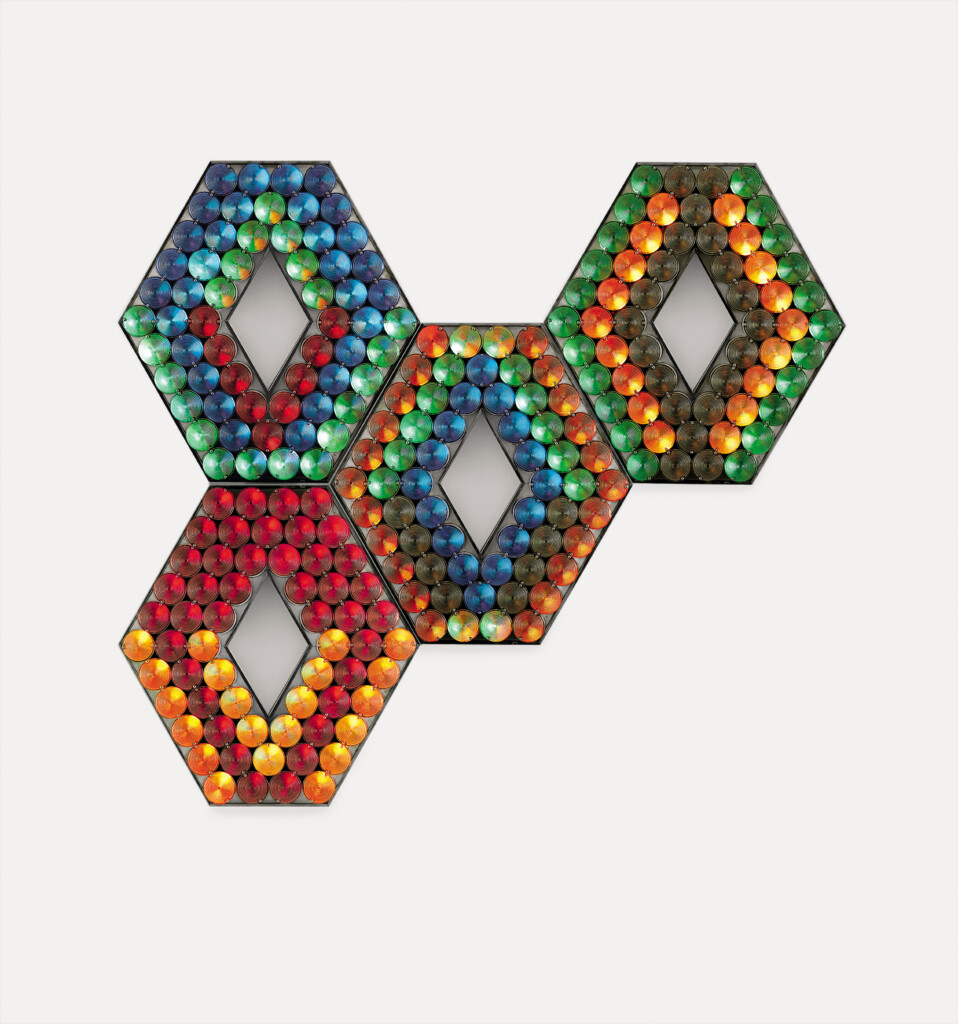
Perhaps the best way to take in the exhibition is to first stand at the entrance of a section of gallery space and scan it in its entirety to appreciate the generous scope of the works being shown. Then, the viewer should take the time to absorb and engage with specific works in each space. An excellent feature that every exhibition visitor should check out is the set of audio responses to specific works presented throughout the galleries, as recorded by various Black leaders, creative producers and professionals in the local community.
The themes emerge in layers. There are works, for example, that reframe stereotypes and empower anew the subjects of the piece not just in gender identity but also in terms of class, history and sexuality. One fascinating area of distinction concerns abstract and representational expressions. Forms, media and materials were not always being explored solely for the purposes of skill and technique but the abstract works also could address the same social, political and cultural critiques and concerns that animate the inspirations behind some of the exhibition’s representational works.
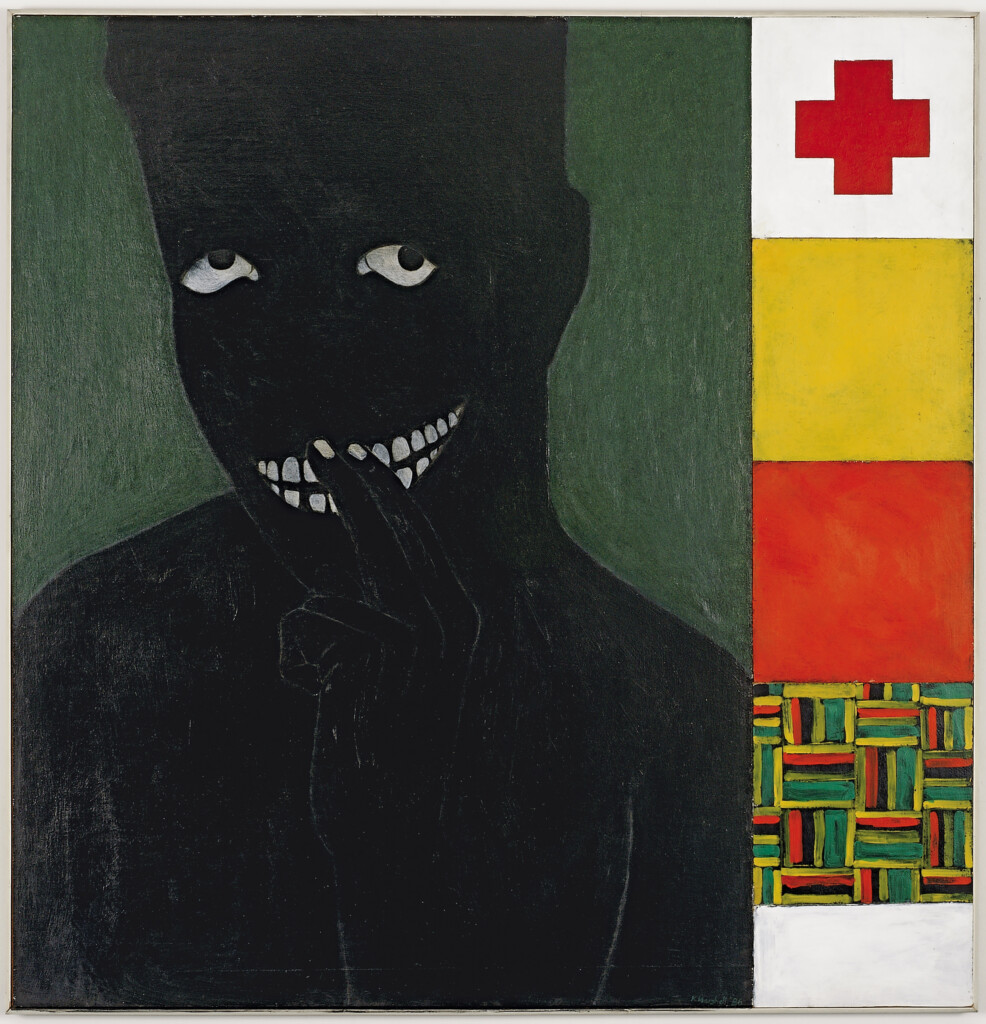
In fact, the title of this current exhibition reflects upon the legacy of the Studio Museum’s founding and in part some of the controversy and negative feedback that arose during the institution’s first solo show. For that first exhibition Electronic Refractions II, the museum selected Tom Lloyd, an African-American sculptor who worked in light. The Queens native already had established a solid, visible reputation for his abstract electronic constructions of aluminum, lightbulbs and plastics laminate. However, the Studio Museum’s opening with the Lloyd show left some in the Harlem community disappointed because they had hoped for work that was specifically representational and relevant to the contemporary voice during the most dramatic, consequential moments of protest and calls for social justice of the time.
One of Lloyd’s works was Moussakoo, a configuration of animated colored lights that have been programmed in diamond-shaped sections and can be arranged in various patterns. The effect is like watching the urban landscape dynamism in terms of the city’s nightlife and business activity, jazz and other musical nightclubs, traffic signals and marquees of a city’s theaters. The Studio Museum acquired the work in 1996 after Lloyd’s death but three of the four original motors for its programming were lost prior to then. Meanwhile, William T. Williams’s 1969 screen prints are compelling additions to the abstract works featured in the show. Evocative of geometric images important in the artist’s life (the urban vibe as well as the craft excellence of his grandmother’s quilts), the prints were part of Williams’s Diamond-in-the-Box motif series, where he placed a diamond shape in a rectangle, which then is refracted and cut through with straight and curved bands of color.
In representational works, the show’s curatorial objectives raise other fruitful areas that demand more than passive viewing for the art’s beauty of form, color, media and technique. Artists reposition how progress and societal advancement should be defined for the benefit and impact of the Black community and what would be the real possibilities of sincere efforts for diversity and inclusion that involve comprehending the multifaceted dimensions of the Black experience in the general American society as well as their own neighborhoods. Marshall’s Silence in Golden is one example.
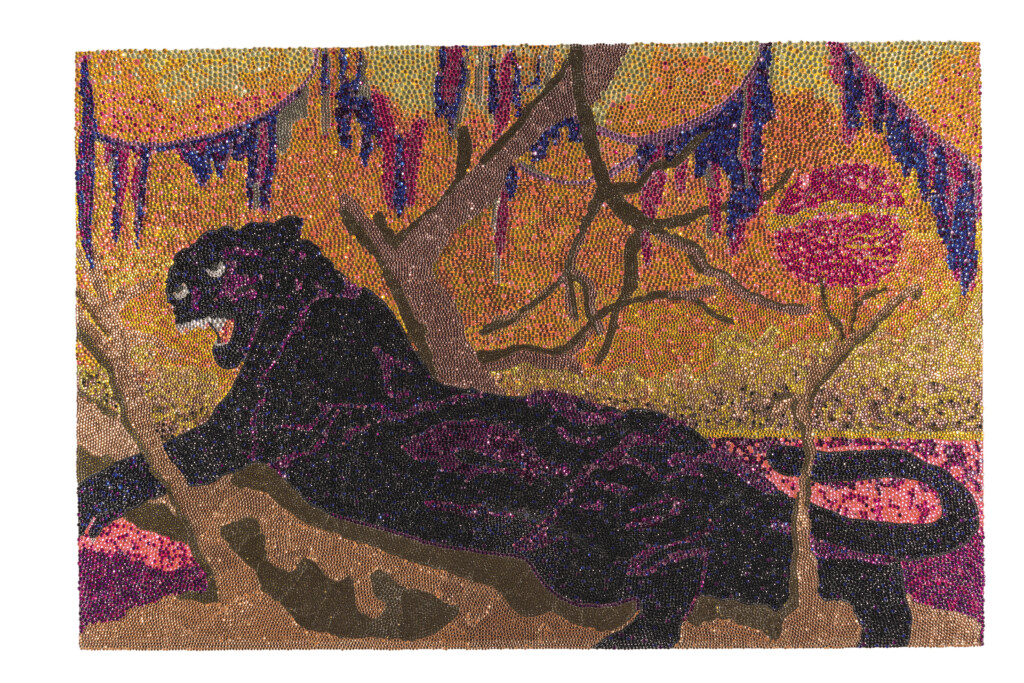
Another is a work from Wiley’s early period when he was an artist in residence at the Studio Museum at the turn of the millennium. His oil canvas painting from 2001, Conspicuous Fraud Series #1 (Eminence), already suggests the well-developed focus of his later works, which would be acclaimed and acquired by major museums. The man’s hair becomes the decorative motif and backdrop in Wiley’s signature interpretation of the portraiture style, as the hair twists and extends across the entire canvas. Meanwhile, the figure commands a larger-than-proportional space in the painting’s composition. Likewise, there are more than a few works in Black Refractions that speak expansively to what encompasses Harlem as a community, a theme integral to the Studio Museum’s own position as a nexus for artists of African descent and as a cultural, entrepreneurial anchor in Harlem.
Indeed, the artist residencies at the Studio Museum have become effective launch pads for the careers of many participants who have used their opportunities to experiment, test and prove their expressive capacities in the visual arts. One significant epiphany in assessing the impact of the residency program at the Studio Museum is how so many artists have astutely appropriated elements of modernism and reinvigorated aspects of portraiture, for example, and other representational styles, mainly because they speak so clearly to the sociopolitical and sociocultural relevance at the current time. So many pieces in the exhibition capture the essential subtle balance of timeliness and timelessness that makes the art as transcendent as it is transformative in perspective. Casteel, for instance, had no formal art training when she entered Yale University’s master of fine arts, with a predominating interest in portraiture. When a jury acquitted George Zimmerman in 2013 for the murder of Trayvon Martin, the news inspired her to adapt portraiture to telling stories of Black men that rebuke racist stereotypes. Moving to Harlem in 2015 to start her residency at the Studio Museum, Casteel said in an interview that Harlem was “the only place [in New York] I’ve ever felt at ease.” There she met street vendors and neighborhood residents such as the kiteman, who is featured in the large portrait included in Black Refractions.
Casteel’s predecessors in the residency program also had set their own bars for challenging the conventions and traditions that have been part of the usual art history canon. Thomas, the artist who created Panthera, also went to Yale and developed a style that blends classical elements with pop culture aspects in portraying Black women and Black feminism. This includes a commissioned portrait of singer and songwriter Solange Knowles. In a Smithsonian magazine interview, Thomas said, ““What’s happening in art and history right now is the validation and agency of the black female body. … We do not need permission to be present.” Incidentally, she also was the subject in a portrait by Wiley.

William T. Williams, whose prints are featured in the show, conceived the Studio Museum’s residency program, which includes studio space, a stipend and an exhibition. Choi says the 11-month program allows artists coming out of schools with their college degrees to “experiment and make work they have never made before.” The open studios are integral to the museum’s programs and the residencies introduce artists to many avenues in the art world — understanding how museums are run, making connections with private collectors and galleries, organizing shows and situating themselves as they see fit in the larger art world.
Many of the alumni in the program, as already noted, enjoy impressive careers including artists whose works are not featured in this traveling show. Wiley’s traveling exhibition A New Republic was seen in seven major museums and received tremendous reviews. A 2012 mixed-media painting by Njideka Akunyili Crosby (The Beautyful Ones, depicting the artist’s older sister) commanded a $3.1 million bid at a Christie’s auction in 2017.
UMFA’s hours are Wednesdays, 10 a.m. to 8 p.m., and Thursdays through Saturdays, 10 a.m. to 5 p.m., with the first hour each day reserved for seniors and high-risk individuals. Gallery capacity is limited and visitors are required to reserve tickets in advance, including for free first Wednesdays and third Saturdays. Visitors are also required to wear face masks and to maintain social distance from other household groups in the galleries.
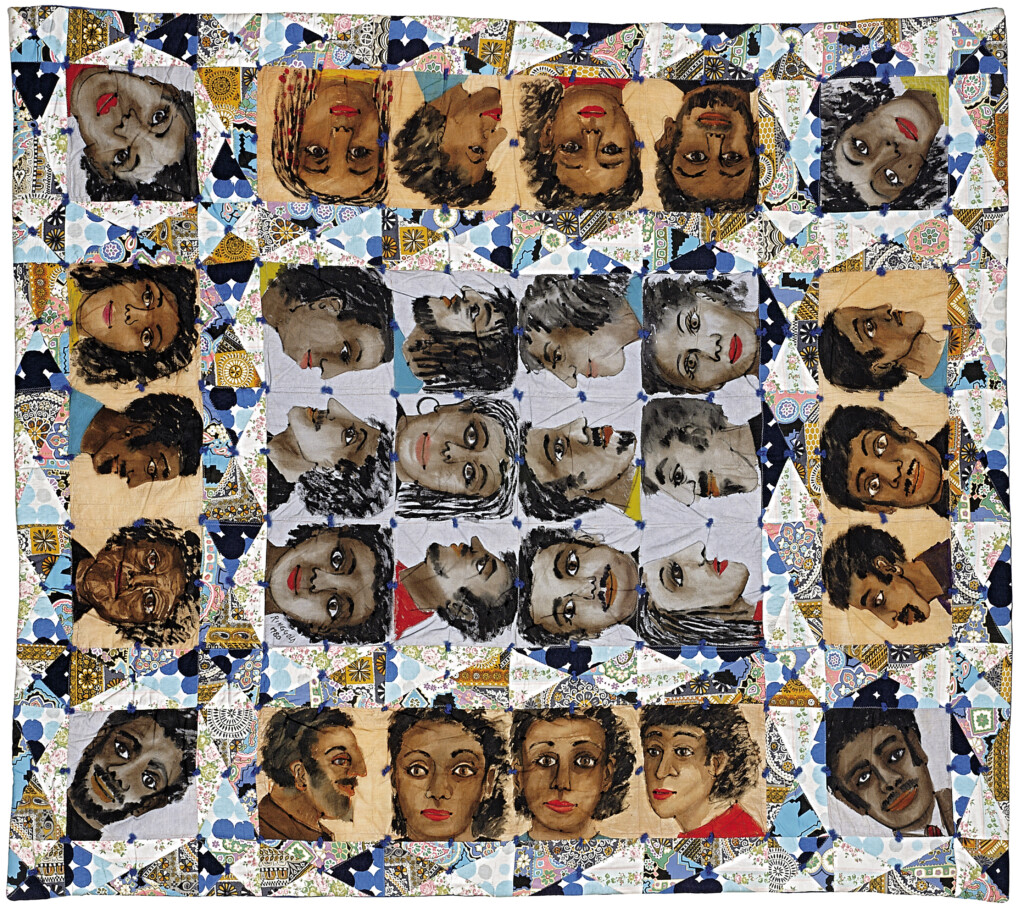
Works from Black Refractions will be on view not only in the museum’s first-floor temporary exhibition galleries but also on the Highlights Wall in the museum’s lobby and in second-floor galleries devoted to modern and contemporary art. A new installation of UMFA contemporary works also focuses on racial and gender inequities.
UMFA is offering various events connected to the exhibition, with advanced tickets required. As part of the museum’s Sight and Sound Series, a free March 3 event, beginning at 6 p.m., will feature DJ Amir Jackson from Ogden, Utah, who will present several generations of soul, jazz and other musical styles, as inspired by works in the exhibition. A two-part ACME session on March 25 and March 27 will include the screening of Charles O. Anderson’s critically acclaimed dance theater project (Re)current Unrest—a meditation on the American Dream and Black nihilism, with Anderson and dance artist Alexandra Barbier leading the March 27 followup workshop.
Major support for Black Refractions: Highlights from The Studio Museum in Harlem is provided by Art Bridges. Sponsorship for the national tour provided in part by PURE. Support for the accompanying publication provided by Furthermore: a program of the J.M. Kaplan Fund.

1 thought on “UMFA presents magnificent, generous traveling exhibition Black Refractions: Highlights from The Studio Museum in Harlem, covering century of quintessential artistic expressions”